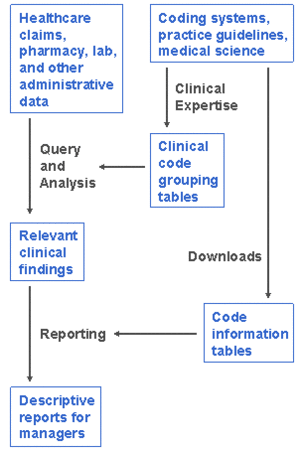John W. Robinson, M.D., Ph.D., LLC
Statistics ▪ Analytics ▪ Data Science
Harnessing Clinical Expertise for Business Intelligence via a Relational Database System
Healthcare organizations often need to query claims or other administrative data for clinical codes (e.g., ICD-9, CPT, NDC, LOINC) relevant to assessments of quality or appropriateness of care. Clinicians working in an organization who are familiar with coding systems can identify groups of relevant codes but may not have the technical expertise to conduct the necessary data queries. Data analysts, on the other hand, may be knowledgeable regarding query techniques but might not have the clinical expertise to identify the relevant codes.
Thus, an approach is needed that coordinates the capabilities of clinicians and analysts. A simple, but inefficient approach is to have clinicians identify a set of codes for each query, to be incorporated (written) by an analyst into an ad hoc program. However, the codes relevant to a particular query are likely to change over time, due to coding system revisions, changes in diagnostic criteria, and evolving standards of clinical appropriateness. Thus, if code sets are "hard-wired" into query programs, changes in code relevance will require program rewrites (analogous to the "Y2K" problem). Moreover, each time a given query is repeated, the analyst will need to ask a clinician to determine if the set of codes imbedded in the program is still valid.
A more efficient approach is to incorporate code groups into a relational database. Database tables linking individual codes with group identifiers can be regularly updated by clinicians. Analysts can simply pull codes from these tables into queries by specifying the appropriate group identifier; e.g., ICD-9 codes representing diabetes, CPT codes representing retinal examination, national drug codes (NDC) representing angiotensin-converting enzyme inhibitors. Since such tables purely represent clinical, scientific and coding system knowledge, clinicians maintaining these tables need understand only the aims, but not the technical details, of the queries for which they will be used. Additional tables can be populated with information about the individual codes useful for reporting (e.g., official names of diagnoses and procedures, drug ingredients); such information can be downloaded in tabular form from sponsoring organizations (e.g., CMS, AMA, FDA).


